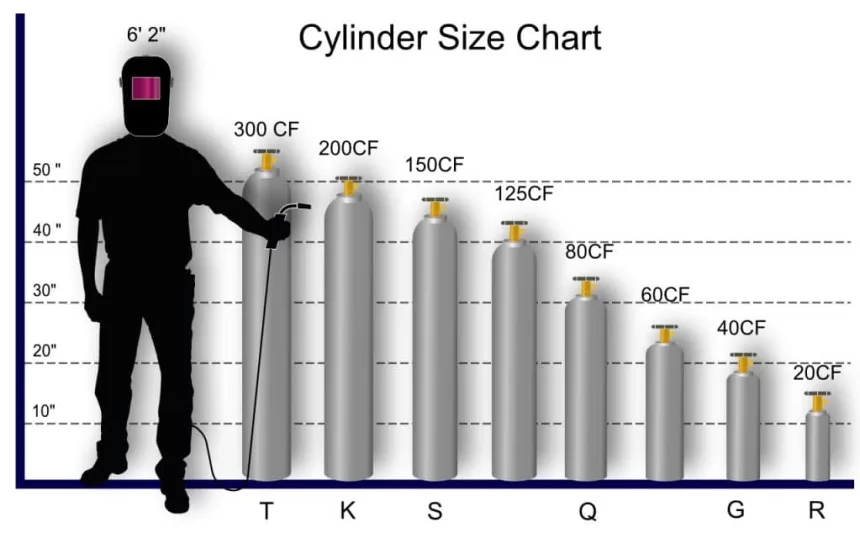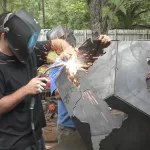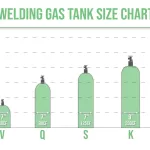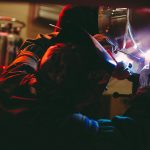To complete your projects, you’ll need a welding bottle of an appropriate size. Selecting the best welding gas tank size for different applications can be a confusing task for many people.
Welding Gas Bottle Size
Welding Town
Sounds tricky? Don’t worry, you’ll learn everything you need to make an informed decision in this comprehensive guide. I have also found the best-value full gas cylinders in 3 different sizes for Argon, and C25, to own outright.
Factors To Consider When You Are Deciding On A Welding Gas Tank Size
The nature of your projects, available space, your work frequency, portability, and even your location plays an important role in determining the best-sized welding gas cylinder for you.
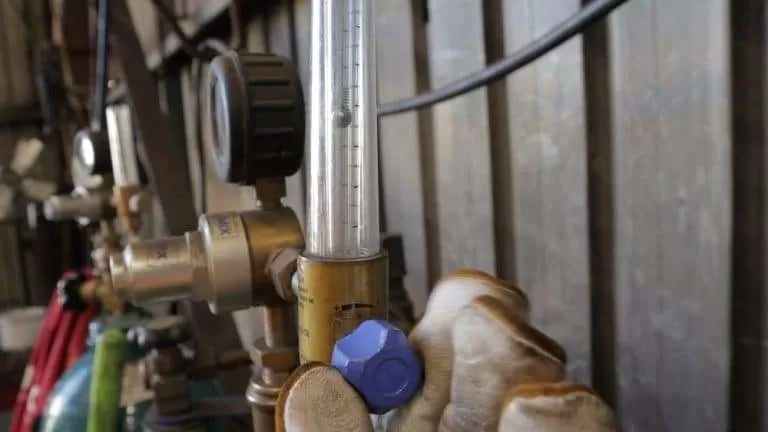
Measuring The Welding Time: CFH and LPM
Calculating the total time for any welding gas bottle size is quite simple. You can use the following formula to find the time in hours.
- Welding time (hours) = Gas bottle volume in cubic feet (cf) / flow rate in in cfh
- How long a particular gas tank can support you is determined by the flow rate. As a welder, you are in charge of determining the required flow rate for a specific job and work with it.
- To measure the welding shielding gas flow rate, either CFH
- Argon Tank Sizes for MIG or TIG Welding
- (cubic feet hour)or LPM (liters per minute) is used. The flow rate most welding professionals usually work on is in the range of 15 – 35 cfh (7-16.5 lpm).
- However, there is no such thing as one size fits all solution. The optimal flow of your shielding gas depends on the welding process and the material or environmental conditions.
For those who are more interested in the technicalities, higher than required flow introduces turbulence in the shielding gas.
This turbulence gives atmospheric gasses a chance to contaminate the welded joint and reduce its quality.
| CYLINDER VOLUME | 300 cu.ft | 150 cu. ft | 80 cu. ft | 40 cu.ft |
|---|---|---|---|---|
| FLOW RATE | ||||
| 15 CFH | 20hrs | 10hrs | 15.3hrs | 2.6hrs |
| 20 CHF | 15hrs | 7.5hrs | 4hrs | 2hrs |
| 25 CFH | 12hrs | 6hrs | 3.2hrs | 1.6hrs |
| 30 CFH | 10hrs | 5hrs | 2.6hrs | 1.3hrs |
| 35 CFH | 8.6hrs | 4.3hrs | 2.3hrs | 1.2hrs |
Best Welding Gas Tank Size For MIG Welding
Metal Inert Gas (MIG) welding is a type of arc welding that uses a consumable electrode to join two metal pieces in a weld pool.
The process is quite straightforward and uses a shielding gas to keep impurities and air to interact with the welded part.
Generally, MIG welding uses a steady supply of shielding gas for protection. You have to select from the common welding gas cylinder sizes given below.
It depends on several factors like your gas choice, how frequently you weld, and your usual volume.
| SIZE | 300 | 200 | 150 | 125 | 80 | 60 | 40 | 20 |
|---|---|---|---|---|---|---|---|---|
| VOLUME cf (m3) | 300 cf (8.5m³) | 200 cf (5.6m³) | 150 cf (4.2m³) | 125 cf (3.5m³) | 80 cf (2.6m³) | 60 cf (1.6m³) | 40 cf (1.1m³) | 40 cf (.56m³) |
| HEIGHT | 55 (140cm) | 51 (130cm) | 47 (120cm) | 43 (110cm) | 32 (81cm) | 23 (58cm) | 17 (43cm) | 14 ( 35cm) |
| DIAMETER | 9.25 (24cm) | 9 (23cm) | 7 ( 18cm) | 7 ( 18cm) | 7 ( 18cm) | 7 ( 18cm) | 7 ( 18cm) | 5 (13cm) |
It is important to mention that the welding gas tank sizes are usually not according to a specific standard because no such thing exists.
This is a common problem when it comes to gas bottles as each manufacturer tries to introduce a unique character to its gas bottle.
So, focus more on the capacity rather than class names. If you can’t find a specific class size, just focus on the characteristics and get the closest one.
Welding Gas Tank Size Chart
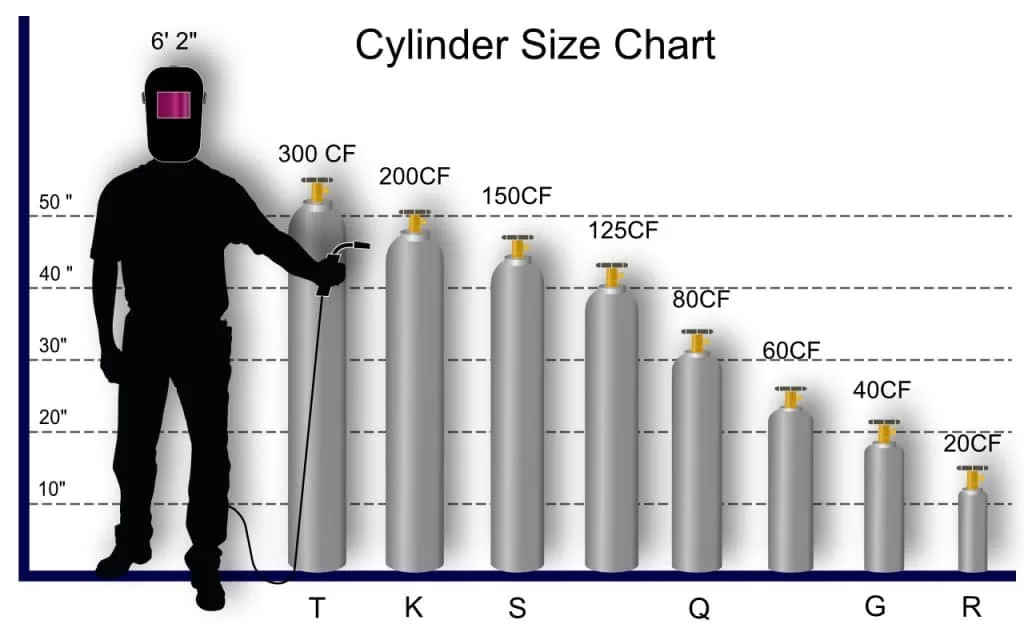
Best Welding Gas Tank Size For TIG Welding
The requirements of TIG welding are slightly different from MIG. Tungsten Inert Gas (TIG) welding was introduced in the 1940s and became an immediate success. One of the reasons behind this process’s popularity is the precise and aesthetic results it delivers.
It’s also the go-to process for experienced welders TIG welding mild steel, aluminum and stainless steel.
Tig welding gasses play a crucial part in this process. When compared to MIG welding, TIG is more unforgiving to shielding errors and requires an experienced hand.
The TIG welding process uses a greater amount of shielding gasses, so using bigger cylinders is recommended.
This is especially true in the case of purging stainless steel, which prevents the welded metal from oxidizing in air.
Even if you have a small TIG welding setup, it is recommended to select a larger tank either K or a T-class gas cylinder for the best experience. You can opt for smaller welding gas tanks as well, but you’ll have to make frequent refilling trips to the market.
Common Gasses For A TIG And MIG Welding Setup
Multiple pure gasses and mixtures are suitable for an arc welding setup. Each gas has its own set of pros and cons, so you must take great care in choosing the welding gas for your application
Some factors that need to be considered before selecting an appropriate gas are welding type, material composition, overall thickness, and so on.
In this article, we’ll only focus on the operational times of the most commonly used welding gasses. You must remember that the times given in the following text are only estimations.
Multiple factors like the joint size, weld puddle size, and weld joint configuration.
Argon
Argon is the third most abundant gas on the planet and that makes it a great choice for multiple applications. It belongs to the group of noble gases, which means that argon will not react with anything, even under the harshest conditions.
In welding applications, argon can be used as both shielding and purging gas. This gas along with Helium is almost exclusively used for TIG welding setups.
Helium, however, is more common in an industrial environment.
If you are planning on working with Aluminum, argon should be your only choice as it is perfect for aluminum welding.
Even in MIG welding applications Argon and its mixtures are quite popular, which makes it one of the most common shielding gases for any welding setup.
Pure Argon is more commonly used in TIG welding, where the flow rate can be anywhere between 15 – 35 cfh. To get an idea of the average welding time, let’s use 47AL, 30AL, and 16AL as welding gas tank sizes.
| CYLINDER VOLUME | 47AL 244 cu. ft | 30AL 141 cu .ft | 16AL 83 cu.ft |
|---|---|---|---|
| FLOW RATE | |||
| 20 CFH | 12.2hrs | 7.05hrs | 4.15hrs |
| 25 CFH | 9.76hrs | 5.67hrs | 3.32hrs |
| 30 CFH | 8.1hrs | 4.7hrs | 2.8hrs |
| 35 CFH | 6.9hrs | 4.02hrs | 2.3hrs |
The tabulated data is from Airliqude, one of the many industrial suppliers of welding gasses.
100% Carbon Dioxide
Carbon dioxide is another common choice for welding enthusiasts looking for an economic option. This gas is not suitable for TIG applications, but it is sufficient for MIG welding.
Some professionals prefer using CO2 as a shielding gas while working with thicker pieces. Carbon dioxide causes deeper penetration but you’ll have to compromise on stability and precision.
MIG setups need a flow rate between 20 – 35 cfh for welding operations. To give you a decent comparison of different welding times, the following table will feature the same welding gas tank sizes as before.
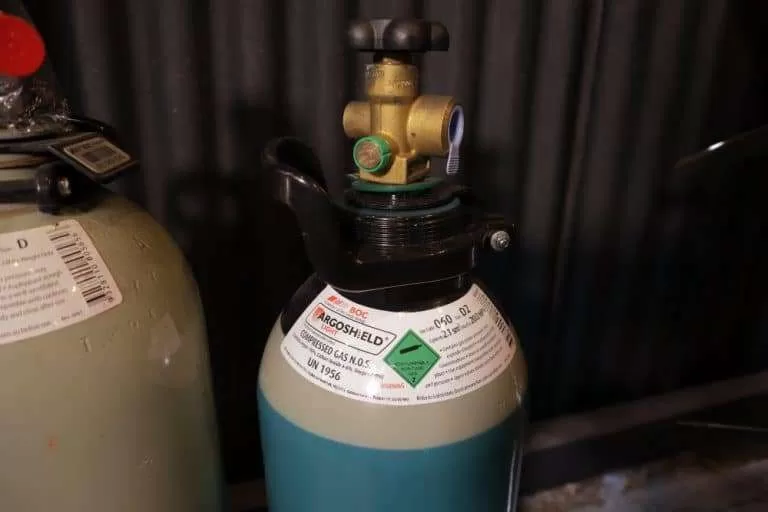
C25: Argon and carbon dioxide mixture
CO2 and Argon mixtures are quite common in the welding industry. The addition of carbon dioxide gives the necessary penetration and argon provides the required smoothness with minimum spatter.
Argon’s composition in the mixture starts from 95% and decreases according to your required application. C25, the mixture of 75% Argon and 25% carbon dioxide, is quite popular as it can handle most welding jobs easily.
Argon and CO2 mixtures are used in MIG welding only and the gas tank size is the flow rate is the same as the one used for 100% CO2.
You can refer to the previous table to know about the average operational times of different welding gas tank sizes.
Welding Gas Tank Material Selection: Aluminum vs Steel
You’ll easily find both steel and aluminum gas bottles for your welding applications. People often feel confused between getting an aluminum cylinder or a steel one. If you are one of them, read on to learn more.
When it comes to welding functionality, steel or aluminum gas tanks won’t make a difference. Both of the options can sustain high pressures and provide similar protections against blasts and other accidents. The only difference is in some physical traits.
Firstly, aluminum gas bottles look far more attractive than their steel counterparts. Aluminum is often used in many applications where the focus is on aesthetics.
The metal can sustain its shine for a long time and continue to look quite new.
Aluminum is also naturally more resistant to rust, so it’s a better choice for humid environments. Some experienced professionals also recommend aluminum gas tanks for choices like carbon dioxide, which can absorb moisture and produce carbonic acid.
This acid can corrode the internal linings of a cylinder and reduce its life.
Finally, aluminum cylinders are easier to handle than steel. Aluminum has a better strength-to-weight ratio, so the cylinder of the same volume will be lighter.
If you want a portable welding setup, choosing an aluminum gas tank is best for you.
An Important Note On Safety
It’s important to emphasize the crucial role of HSE practices in your workplace.
You must follow certain safety protocols when working with welding gasses and the high-pressure cylinders that store them. All of the gasses require unique conditions with certain pressures.
For instance, even a smaller cylinder of Argon may reach up to a maximum pressure of 20,000 psi, which is about 13,900 kPa.
These highly pressurized gas cylinders may cause major injuries if not handled with care. You are recommended to brush up on the important safety guidelines here.
The Best Welding Tank For You
As stated before, there is no one size fits all solution for welding gas tank sizes. It purely depends on your preferences and applications.
Even with a smaller tank, you’ll be able to work on even the most complicated jobs. However, you’ll have to take a trip to the filling point every other day.
You should base the decision of your welding gas tank size by considering the applications and the available space on your welding cart.
It’s better to have a larger gas tank if you purge frequently and if your welding cart can sustain the weight.







